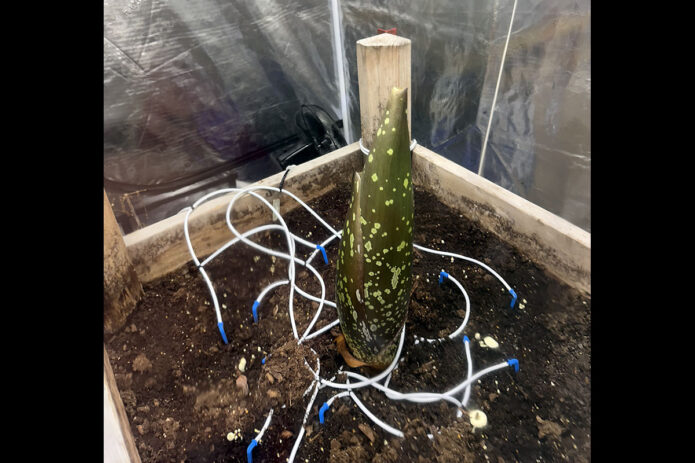 Clarksville, TN – It was the summer of corpse flowers. In late June, members of the Austin Peay State University (APSU) College of Science, Technology, Engineering and Mathematics (STEM) were given the all-clear to begin once more utilizing the on-campus greenhouse.
Clarksville, TN – It was the summer of corpse flowers. In late June, members of the Austin Peay State University (APSU) College of Science, Technology, Engineering and Mathematics (STEM) were given the all-clear to begin once more utilizing the on-campus greenhouse.
This had been a long time coming.
Multiple storms had damaged the greenhouse, including a devastating hailstorm in May 2024. Austin Peay State University’s prized corpse flowers – massive Titan arums that can reach 8 feet tall – had to be evacuated. Zeus, who first bloomed three summers ago in 2022, found temporary refuge at the Nashville Zoo.
The university’s second plant, unnamed at the time, moved into a makeshift incubator in the Technology Building High Bay, where she waited. Corpse flowers traditionally earn their names only after their first bloom.
When it came time to move the plant from the High Bay back to the greenhouse, a fun, if complicating factor arose – it was beginning its bloom cycle, and that meant preparing for visitors.
The team mobilized just as they had for Zeus in 2022, when thousands traveled from across the country to witness his debut. Stickers were printed, Dr. Donald Sudbrink prepared educational displays about the beetles that pollinate these giants in their native island of Sumatra, and the entire college rallied to the cause.

Athena – as she would soon be christened – did not bloom until Fourth of July weekend. Fittingly, she bloomed in the same hour (3:00pm) on the same day (five days after the external leaflets began to fall) as Zeus, symmetrically aligning her own debut with her brother’s.
From June 26th, when the greenhouse was ready to welcome people back through its doors, through Athena’s post-bloom period on July 5th, more than 2,000 people passed through the greenhouse. They learned about corpse flowers from Dr. Karen Meisch and Dr. Amy Thompson and inhaled the sickly-sweet scent once she opened just before Independence Day. On Thursday, July 3rd, representatives from the College of STEM kept vigil until nearly midnight, allowing visitors an after-hours chance to see Athena as she neared full bloom.
In addition to the thousands who made the trek to see Athena in person – some from as far away as Florida – hundreds more monitored her progress on a YouTube livestream. News crews from Clarksville and Nashville covered the event, which also merited a mention on NPR’s nationally renowned News Now segment. In total, articles about the event were viewed by more than 1.5 million unique visitors online and more than 20 million people were reached by broadcast news clips. Social media hummed as well, with 120,000 impressions across all platforms.
Late in the bloom process, Thompson harvested the pollen from Athena for a later pollination. Just when the excitement of Athena’s first bloom seemed to settle, one final flourish made the greenhouse whole again: Zeus returned from the Nashville Zoo to reunite with his sister.
This event would not have been possible without the combined efforts of the College of STEM coming together to support Athena during her bloom, beginning with the student workers (Madeline Thompson, Sai Nesanuru, Stacy Murphy and Neel Patel) who sacrificed part of their summer to help make everything run smoothly.
Jessica Verrillo with the Department of Biology created posters that adorned the walls with useful information for those waiting in line. Dr. James Church of the Department of Computer Science and Information Technology got the livestream up and running, while Dr. Antonio Thompson was on-site to help with all manner of concerns.
Biology instructor Michelle Rogers and graduate student Connor Burgal were dedicated to taking care of Athena during her bloom, and the College of STEM’s academic assistant Mary Biggers provided valuable support throughout the process.
Dr. Carol Baskauf, who procured and took care of Austin Peay’s corpse flowers until her retirement, also continues to advise everyone regularly working with Zeus and Athena. She provided vital information and counsel during Athena’s first bloom.Zeus bloomed first in 2022 and again in 2024; Athena for the first time in 2025. Today they rest in their restored greenhouse, their next cycle a mystery that could unfold in two years or 10. But whether the university has a corpse flower blooming next year or next decade, the most spectacular things are always worth waiting for.
About the Austin Peay State University College of STEM
The Austin Peay State University College of Science, Technology, Engineering & Mathematics (STEM) provides studies for students in the areas of agriculture, astronomy, aviation sciences, biology, chemistry, computer science, earth and environmental sciences, engineering physics, engineering technology, information technology, mathematics, medical laboratory sciences, radiologic sciences and physics.
Our outstanding, discipline-based programs are student-centered and designed to prepare students for responsible positions at all levels of research, industry, education, medicine and government.



